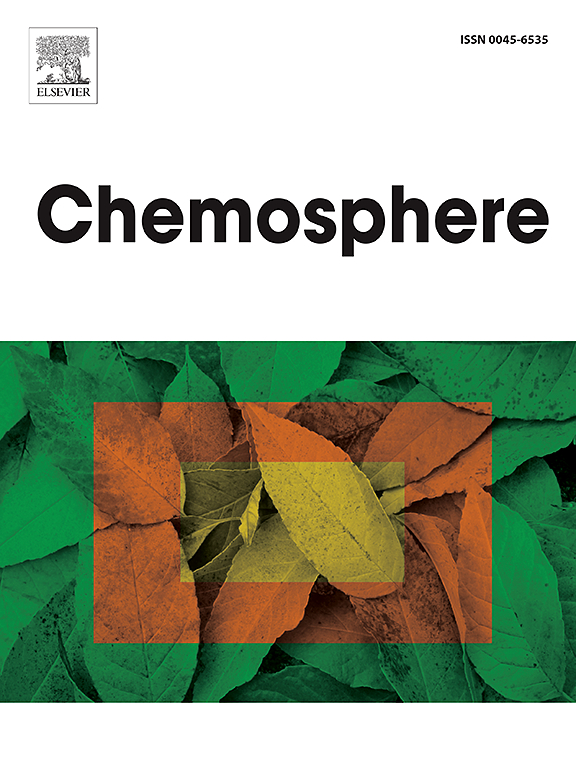出生后 6 个月婴儿尿液中 18 种环境酚的浓度及其与喂养模式的关系。
IF 8.1
2区 环境科学与生态学
Q1 ENVIRONMENTAL SCIENCES
引用次数: 0
摘要
环境酚类是一组典型的内分泌干扰物,可在母乳和婴儿配方奶粉中广泛检测到。然而,婴儿早期是环境污染物暴露的一个特别敏感的时期,而这一时期的暴露数据却很少。我们旨在前瞻性地评估出生至 6 个月婴儿尿液中 18 种环境酚的浓度及其与喂养模式(母乳喂养、配方奶喂养和混合喂养)的关系。这项研究包括 197 对母婴。通过高效液相色谱-串联质谱法(HPLC-MS/MS)测量了婴儿出生 3 天、42 天、3 个月和 6 个月时尿液中六种对羟基苯甲酸酯(PB)、七种双酚、四种二苯甲酮(BP)和三氯生的浓度。采用多变量线性回归模型来评估婴儿喂养类型与尿液中酚浓度之间的对数10转换关系。双酚 A 和 S、4-羟基苯甲酸甲酯(MeP)、4-羟基苯甲酸乙酯(EtP)和 4-羟基苯甲酸丙酯(PrP)的检出率在所有年龄段(3 天、42 天、3 个月和 6 个月)都持续较高(范围为 48.7%-100.0%)。双酚 P、B 和 AP 的检出率在 3 天龄时较高(范围为 76.9%-95.9%),而在较后的年龄段则较低(14.4%-88.0%)。与纯母乳喂养相比,混合喂养在 42 天时与 log (BPA) (μg/g 肌酐) 升高 0.32 (95% CI: 0.01, 0.62, p < 0.05) 相关,在 3 个月时与 log (TCS) (μg/g 肌酐) 升高 0.69 (0.03, 1.35) 相关,在 3 个月时与 log (EtP) 升高 0.54 (0.08, 1.00) 相关。配方奶喂养的婴儿在 42 天大和 3 个月大时,log(BPB)(微克/克肌酐)分别比配方奶喂养的婴儿高 1.30(0.59,2.00)和 0.91(0.22,1.60),log(BPP)(微克/克肌酐)比配方奶喂养的婴儿高 1.19(0.003-2.37),log(BPS)(微克/克肌酐)比配方奶喂养的婴儿高 0.95(0.27-1.64)。总之,婴儿在出生后早期广泛接触双酚 A 及其类似物和对羟基苯甲酸酯(MeP、EtP 和 PrP)。母乳喂养可能是婴儿避免接触某些酚类物质的更安全的喂养方式。本文章由计算机程序翻译,如有差异,请以英文原文为准。

Urinary concentrations of eighteen environmental phenols and the associations with feeding pattern in infants in the first 6 months of life
Environmental phenols are a group of typical endocrine disruptors, and widely detectable in human breast milk and infant formulas. However, exposures data are scarce in early infancy, a particularly sensitive period to environmental pollutants exposures. We aimed to prospectively assess urinary concentrations of eighteen environmental phenols in infants from birth to 6 months of age and their associations with feeding patterns (breastfeeding, formula and mixed-feeding). This study included 197 mother-infant pairs. Urinary concentrations of six parabens (PBs), seven bisphenols, four benzophenones (BPs) and triclosan were measured in infants at the ages of 3 days, 42 days, 3 and 6 months by high performance liquid chromatography-tandem mass spectrometry (HPLC-MS/MS). Multivariable linear regression models were applied to evaluate the associations between infant feeding types and urinary phenol concentrations in log10-transformed scale. The detection rates of bisphenol A and S, methyl 4-hydroxybenzoate (MeP), ethyl 4-hydroxybenzoate (EtP), and propyl 4-hydroxybenzoate (PrP) were persistently high (ranged 48.7%–100.0%) across all ages (3 days, 42 days, 3 and 6 months). The detection rates of bisphenol P, B and AP were high (ranged 76.9%–95.9%) at age 3 days, and lower (14.4%–88.0%) at later ages. Compared to exclusive breastfeeding, mixed feeding was associated with 0.32 (95% CI: 0.01, 0.62, p < 0.05) higher log (BPA) (μg/g creatinine) at 42 days, 0.69 (0.03, 1.35) higher log (TCS) (μg/g creatinine) at 3 months, 0.54 (0.08, 1.00) higher log (EtP) (μg/g creatinine) at 6 months; formula feeding was associated with 1.30 (0.59, 2.00) and 0.91 (0.22, 1.60) higher log (BPB) (μg/g creatinine) at the age of 42 days and 3 months respectively, 1.19 (0.003–2.37) higher log (BPP) and 0.95 (0.27–1.64) higher log (BPS) (μg/g creatinine) at 3 months. In conclusion, exposures to BPA and its analogs, and parabens (MeP, EtP, and PrP) were extensive in early postnatal life of infants. Breastfeeding might be a safer form of feeding for infants against exposure to some phenols.
求助全文
通过发布文献求助,成功后即可免费获取论文全文。
去求助
来源期刊

Chemosphere
环境科学-环境科学
CiteScore
15.80
自引率
8.00%
发文量
4975
审稿时长
3.4 months
期刊介绍:
Chemosphere, being an international multidisciplinary journal, is dedicated to publishing original communications and review articles on chemicals in the environment. The scope covers a wide range of topics, including the identification, quantification, behavior, fate, toxicology, treatment, and remediation of chemicals in the bio-, hydro-, litho-, and atmosphere, ensuring the broad dissemination of research in this field.
 求助内容:
求助内容: 应助结果提醒方式:
应助结果提醒方式:


